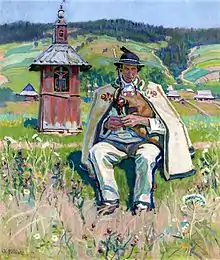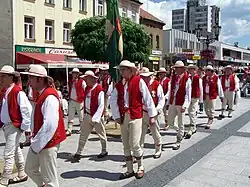Gorals
The Gorals (Polish: Górale; Goral dialect: Górole; Slovak: Gorali; Cieszyn Silesian: Gorole), also known as the Highlanders (in Poland as the Polish Highlanders, a subethnic group of the Polish nation) are an ethnographic subgroup primarily found in their traditional area of southern Poland, northern Slovakia,[1] and in the region of Cieszyn Silesia in the Czech Republic, where they are known as the Silesian Gorals.[2] There is also a significant Goral diaspora in the area of Bukovina in western Ukraine and in northern Romania, as well as in Chicago, the seat of the Polish Highlanders Alliance of North America.
History
The Gorals as a separate ethnographic subgroup began to form in the 14th century[3] with the arrival of the first Polish settlers from Lesser Poland,[4] who would settle and farm the lands around what is today Nowy Targ and along the Dunajec valley beginning in the early twelve hundreds. Prior to that, Podhale was an uninhabited region sparsely populated by bandits who chose the inaccessible mountainous terrain to hide from justice.[5] Then between the late 13th and 15th centuries, Vlach shepherds migrated to the region, gradually moving northwest from the Balkan peninsula over the Carpathian Mountains and settling on Polish lands there.[6][7] The initial contact of the locals with the Vlachs was difficult. The medieval chronicler Jan Długosz described the nomadic shepherds as brutish and lawless.[8] However, the newcomers brought with them a distinct method of raising livestock in the mountains, which was different from the one practiced by the settlers from the lowlands of Lesser Poland and thus with the merging of the two cultures, a new local way of life began to emerge,[9] and the subsequent assimilation of the Vlachs.[10]

In the 16th and 17th centuries, Gorals settled the upper Kysuca and Orava rivers and part of northern Spiš in Slovakia,[11][12] which at the time were part of the Kingdom of Hungary.[13][14][15][16] Due to various rights and privileges, including the Vlach law,[17] Gorals enjoyed freedom from serfdom and held a substantial amount of autonomy. Also, distinct within the Goral culture were Zbójnicy, these were members of local robber bands in the western Carpathians.[18] They were recognized as folk heroes who helped exploited Gorals by stealing from the rich and giving back to the poor. The most famous of these was Juraj Jánošík from the village of Terchová located in the Žilina region on the Slovak side of the Carpathian mountains. As a youngster, he fought with the Kuruc insurgents against the Habsburg monarchy and later formed his own band of robbers.[19] The phenomenon became widespread in the mid-16th century and disappeared in the 19th century with the death of Wojciech Mateja who was considered as the last Zbójnik.[20]
In 1651, the Gorals and local peasantry of Podhale rebelled against the Polish nobles (szlachta) in what became the Kostka-Napierski uprising, led by the adventurer and officer from the Polish army captain Aleksander Kostka Napierski. A film was produced about the uprising (Podhale w ogniu) in 1956, and distributed in many languages across the Eastern Bloc.[21][22][23] A second peasant rebellion in Podhale occurred in 1669, when Gorals and local peasants rebelled against high taxes and oppressive rule imposed on them by the nobility. The first Polish national opera, titled Krakowiacy i Górale (Cracovians and Gorals) composed by Wojciech Bogusławski premiered in 1794.[24] In the 19th century, between 1803 and 1819, the Gorals migrated to Bukovina.[25]
During World War II, Nazi Germany sought to Germanize the Gorals.[26] Under Nazi racial laws, the majority of Poland's population and its minorities were viewed as "undesirable" and subject to special statutes, slave labour and martial law.[27] However, Nazi racial theorists considered the 27,000 strong Goral population as a separate ethnic group from the Poles.[28] Termed Goralenvolk, they were deemed part of the greater Germanic race and given milder treatment from other Poles.[29][30] Between 1939 and 1945, local Gorals of Podhale joined the resistance movement, including the Tatra Confederation and the IV Batalion Nowy Targ of the 1st Regiment of Home Army Podhale Rifles and fought against Nazi occupation of Poland.[31]
Population
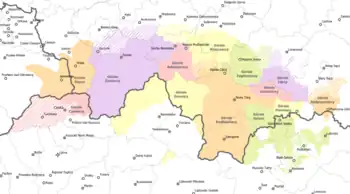
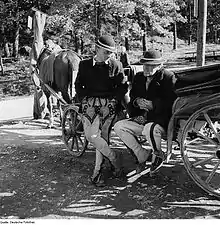
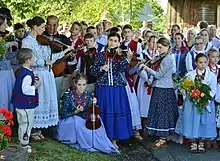
The Gorals inhabit a number of regions collectively referred to as the "Goral lands" (Goral: Góralscýzno, Polish: Góralszczyzna) split between Poland, Slovakia and the Czech Republic. In Poland, the community inhabits the geographical region of Podhale of the Tatra Mountains and parts of the Beskids (Cieszyn Silesia, Silesian Beskids, Żywiec Beskids).[32][33][34] After 1945, some Górals from Bukovina and the Podhale regions found new homes in Lower Silesia in villages such as Krajanów, Czarny Bór, and Borówna in the Central Sudete Mountains, as well as Złotnik, Brzeźnica and Lubomyśl in Lubusz Voivodeship.
In present-day Slovakia they live in 4 separate groups: in northern Spiš (34 villages subdivided into two groups), Orava and Kysuce (2 villages) and smaller groups in 7 other enclave villages in northern Slovakia.
The main towns of Goral lands include:
Language
The various dialects spoken by the Gorals descend from the Proto-Indo-European, West Slavic, Lechitic and Eastern Romance languages. In particular, the dialect spoken in Podhale, called the Podhale dialect (Polish: gwara podhalańska), is of Polish origin and part of the Lesser Polish dialect cluster, but it has been considerably influenced by Slovak in recent centuries.[35] In addition to Slovak, the Goral dialects contain some vocabulary from Hungarian and other Balkan languages.[36] Kazimierz Dobroslowski asserted that the Podhale dialect had loan-words from Romanian and Albanian, as well as similar belief system elements, music and material culture.[37]
One of the features of the Podhale dialect is mazuration.[38] Also, 14th- and 15th-century palatal consonant pronunciation features (called "Podhale archaisms") are preserved in the Podhale dialect.[39]
The Podhale dialect is the de facto standard literary Goral dialect due to Podhale being the most famously known region. However, the majority of Gorals speak closely related dialects. Gorals themselves rarely differentiate between their dialects and just refer to them as Górolski.[40]
National identity

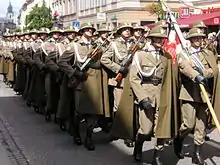
For most Gorals today, the decisive factor in their self-identification with nationality is not ethnic but territorial. For example, those living in areas under a long tradition of belonging to the Polish state identify themselves as Polish, while those living in Slovakia have identified themselves as Slovaks, with notable exceptions to this rule on both sides of the border. While the origin of the Goral dialect is Polish,[41] the language of Gorals in Slovakia and in the Czech Republic is gradually shifting and increasingly becoming more similar to the literary standard in their respective countries.
Silesian Gorals of the Czech Republic identify themselves on the nationality level as Poles and are members of the Polish minority in the Czech Republic, which is proved by their communal activity: the annual Gorolski Święto festival held in Jablunkov is a showcase of a local Polish Goral traditions and is organized by the PZKO (Polish Cultural and Educational Union). This Goral festival preserves the traditions of the Polish nationality group in Trans-Olza.[42] It is the largest cultural and folklore festival in Trans-Olza gathering thousands of spectators each day of festivities. However, the Poles do not form a majority in any of the municipalities of the area, and some local Gorals identify themselves on the nationality level as Czechs. In this respect, the village of Hrčava (the second easternmost village in the Czech Republic), with the vast majority of citizens declaring Czech nationality, can be noted. In this village, the Poles form only a 2% minority.[43] Local Silesian Gorals formed a majority in the past and they speak the regional Cieszyn Silesian dialect in everyday communication. In Slovakia, Gorals are seeking formal recognition as a minority,[44] however they do not identify themselves as Polish.[45]
Historically, the issue of their ethnic identity has been controversial and resulted in claims and counterclaims by both Poland and Czechoslovakia. Gorals, like many other peasant communities in Central Europe, determined their own ethnic identities within the nation-state system during the 19th and early 20th century.[46] Although nationalist propaganda was generated by both Poles and Slovaks, this process of the Gorals' identification with a nationality was still not complete when the border was finalized in 1924. A notable example was Ferdynand Machay, a priest born in Jabłonka, Orava, Piotr Borowy from Rabča, Orava and Wojciech Halczyn from Lendak, Spiš, who went to the 1919 Paris Peace Conference and, during a personal audience, lobbied U.S. president Woodrow Wilson to sign these lands over to Poland.
The Gorals have a similar belief system elements, music and material culture as that of the Vlachs and related groups (e.g. Moravian Vlachs), from whom it has been argued they originate.[47] Anthropologist Carleton Coon grouped Gorals with the Hutsuls, who dwelled in what was then the southeastern corner of Poland and is now southwestern Ukraine.[48] In the 19th century, Polish scholars viewed the Gorals as linguistically close to the Poles, but having close ties with Slovak folk culture.[49] It was noted that Gorals' social and economic life resembled that of Vlach shepherd culture.[49]
Culture
Architecture
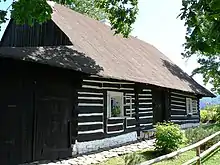
The Zakopane Style architecture, established at the end of the 19th century, is held as a Goral tradition. The architectural style draws on local architecture and Vernacular architecture of the Carpathians, and is widespread in the Podhale region.
Music
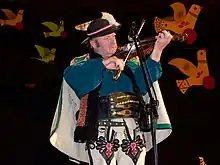
Zakopower is a popular folk-pop musical group from Zakopane. The Trebunie-Tutki folk musical group from Zakopane blend traditional Goral music with reggae.
Clasps
For centuries clasps have been an important element of Goral traditional costumes. Originally used for fastening shirts, they fell out of use when buttons became popular, remaining only as ornaments. In the early 20th century they were already rare, used only by senior and young shepherds, who grazed their sheep on mountain pastures. In the 1920s and the 1930s, they were considered collector's items and sought after by tourists. In Zakopane, they were often worn as ornaments for the "cucha" (outerwear), sweaters, or occasionally on leather bags. Today the clasps are a popular element of highlanders from the Podhale region, but the way they are worn differs from the original one: instead of fastening shirts they are usually attached to them or sewed on.[50]
Parzenica (embroidery)
The parzenica embroidery dates back to the mid-19th century. Initially, they were simple string loops, used for reinforcing cuts in front of cloth trousers. They had practical functions and protected the cloth from fraying. The modern look parzenica got from those tailors who began using red or navy blue string, simultaneously increasing the number of loops. Later the appliqué design was replaced with embroidery. Using woollen yarn allowed the parzenica to become more colourful and eventually it became a stand-alone trouser ornamentation, developed by talented tailors and embroiderers.[51]
Corsets
In the second half of the 19th century, it became fashionable in the Podhale region to adorn corsets with depictions of thistle and edelweiss. These motifs were the most popular in the early 20th century. When "Kraków style" came into fashion, highlanders of the Podhale region began ornamenting the corsets with shiny sequins and glass beads.[52]
Other
In Cieszyn Silesia and northern Slovakia, the shepherd's axe and elements of the folk costume are termed Vlach (Polish: wałaska, wałaszczaki, Slovak: valaška).[53]
Goral folk costumes can be found in the National Museum of Ethnography in Warsaw,[54][55] The Tatra Museum in Zakopane, the Ethnographic Museum of Kraków, and the City Museum of Żywiec.
Religion
Most Gorals are adherents of the Roman Catholic Church and are often noted for their staunch religiosity. The Sanctuary of Our Lady of Ludźmierz is of particular significance to the Gorals, being the oldest shrine in the Podhale region. Also, there are numerous Catholic religious cults and traditions connected to the church.
The Polish Gorals also hold a particular reference for Pope John Paul II, who they consider as their own, even though Karol Wojtyła was born in Wadowice, Lesser Poland and was not a Goral himself. However, the Late Pope was always considered as "the son of the mountains" by the Gorals.[56]
A notable portion of Gorals are Augsburg Confession Lutherans, who are clustered around the town of Wisła. This is the main centre of Protestant Gorals, and it is the only city in Poland where Catholics are a minority.[57]
Notable people
- Tomasz Adamek (born 1976), Polish boxer and WBC light heavyweight and IBF cruiserweight champion
- Klemens Bachleda (1851–1910), Polish mountain guide
- Alicja Bachleda-Curuś (born 1983), Polish actress
- Stefan Banach (1892–1945), Polish mathematician
- Tadeusz Błażusiak (born 1983), Polish sport motorcyclist
- Józef Cukier (1889–1960), Goralenvolk leader
- Andrzej Dziubek (born 1954), Polish–Norwegian musician
- Wojciech Fortuna (born 1952), Polish ski jumper and Olympic gold medalist
- Sebastian Karpiel-Bułecka (born 1976), Polish singer
- Justyna Kowalczyk (born 1983), Polish cross-country skier and Olympic gold medalist
- Wacław Krzeptowski (1897–1945), Goralenvolk leader
- Dawid Kubacki (born 1990), Polish ski jumper and Olympic bronze medalist
- Jerzy Kukuczka (1948–1989), Polish alpinist
- Adam Małysz ( born 1977) Polish ski jumper and Olympic silver medalist
- Władysław Orkan (1875–1930), Polish writer
- Jan Kanty Pawluśkiewicz (born 1942), Polish composer
- Kazimierz Przerwa-Tetmajer (1865–1940), Polish writer
- Kamil Stoch (born 1987), Polish ski jumper and Olympic gold medalist
- Augustyn Suski (1907–1942), Polish poet and World War II resistance fighter
- Włodzimierz Tetmajer (1861–1923), Polish painter
- Józef Tischner (1931–2000), Polish priest and philosopher
See also
- Gorani, a Slavic Muslim highlander people in Kosovo
- Polish Uplanders
References
- "Sociológ Ábel Ravasz: Ak štát nevie mapovať svoje menšiny, nevie im ani pomáhať". dunszt.sk (in Slovak). Retrieved 30 August 2023.
Gorali, podobne ako Rusíni, žijú na oboch stranách štátnej poľsko-slovenskej hranice[...] Je to veľmi vzácna a zvláštna subskupina v tom, že jej jazyk pripomína skôr poľštinu s istými prvkami slovenčiny[...]
- Sparks, Alan E. (2020). Into the Carpathians. Vol. 2. Boulder, Colorado: Rainy Day Publishing. ISBN 9780578705729.
- "Górale Historia". Nowe Bystre (in Polish). Retrieved 31 July 2023.
Górale podhalańscy jako odrębna grupa zaczęła kształtować się w XIV wieku.
- "Skąd się wzięli górale na Podhalu". Do Rzeczy (in Polish). 27 January 2018. Retrieved 31 July 2023.
Pierwsi śmiałkowie wędrowali ku Tatrom z Małopolski doliną Raby, przez dzisiejszą Mszanę Dolną, potem w poprzek Gorców ku wsiom Niedźwiedź i Obidowa, by połączyć się w Klikuszowej z trasą dzisiejszej zakopianki.
- "Skąd się wzięli górale na Podhalu". Do Rzeczy (in Polish). 27 January 2018. Retrieved 31 July 2023.
Przed 1234 r. musieli być tu ludzie, skoro przywilej dla Teodora Gryfity z rąk Henryka Brodatego wymienia już jakieś nazwy. Osadnicy ci składali się zapewne z elementu przestępczego, który wybrał niedostępne tereny górskie dla ukrycia się przed sprawiedliwością.
- "Skąd pochodzą górale? Inwazja Wołochów zmieniła historię polskich gór". Nasza Historia (in Polish). 23 November 2017. Retrieved 26 April 2022.
W XIII w. na ziemiach polskich zaczęli się pojawiać Wołosi, osadnicy z Bałkanów, którym udało się ujarzmić Karpaty i wprowadzić tu gospodarkę pasterską.
- "Wieś podhalańska i jej gospodarcze przeobrażenia w historii regionu". uj.edu.pl (in Polish). Retrieved 1 August 2023.
Od XV w., oprócz ludności polskiej, na Podhale zaczęła napływać ludność pochodzenia rumuńskiego – Wołosi. Zajmowali się oni wypasem bydła i owiec.
- "Skąd się wzięli górale na Podhalu". Do Rzeczy (in Polish). 27 January 2018. Retrieved 31 July 2023.
Zetknięcie miejscowych z Wołochami było szorstkie. Długosz opisywał ich jako ludzi prymitywnych, brutalnych i skorych do rozboju.
- "Wieś podhalańska i jej gospodarcze przeobrażenia w historii regionu". uj.edu.pl (in Polish). Retrieved 1 August 2023.
Nowi przybysze sprowadzili na te tereny inne niż osadnicy z nizin sposoby gospodarowania. W ten sposób wywodząca się z Małopolski gospodarka folwarczna wzbogaciła się o tradycyjne formy chowu zwierząt w górach, rządzące się innym prawem i odmienną obyczajowością. W tym spotkaniu dwóch kultur rolniczych wiodącymi pozostały sposoby gospodarowania przyniesione z nizin, w jakimś tylko zakresie dostosowane do lokalnych warunków siedliskowych i wołoskich systemów chowu zwierząt gospodarskich w górach.
- "Górale". Encyklopedia PWN (in Polish). Retrieved 3 September 2023.
Karpaty były od XV w. zasiedlane przez ludność wołoską, która na północnych stokach polonizowała się, na południu ulegała wpływom słowac.
- Denes Loczy; Miloš Stankoviansky; Adam Kotarba (3 January 2012). Recent Landform Evolution: The Carpatho-Balkan-Dinaric Region. Springer Science & Business Media. pp. 149ff. ISBN 978-94-007-2447-1.
- "Słowacja: Będzie narodowość goralska?". beskidzka24.pl (in Polish). 14 January 2021. Retrieved 4 September 2023.
[...]pomiędzy XVI a XVIII wiekiem wiele osób z terenu Polski osiedlało się w tych słowackich regionach, przynosząc ze sobą swój język i gwarę.
- Karoly Kocsis; Eszter Kocsisne Hodosi (1 April 2001). Ethnic Geography of the Hungarian Minorities in the Carpathian Basin. Simon Publications LLC. pp. 45–46. ISBN 978-1-931313-75-9.
- Redakcja (2017-11-23). "Skąd pochodzą górale? Inwazja Wołochów zmieniła historię polskich gór". Nasza Historia (in Polish). Retrieved 2022-03-13.
- "Górole Historia". www.nowebystre.pl. Retrieved 2022-03-13.
- "Górale Podhalańscy - Etnozagroda". www.etnozagroda.pl. Retrieved 2022-03-13.
- "Skąd pochodzą górale? Inwazja Wołochów zmieniła historię polskich gór". Nasza Historia (in Polish). 23 November 2017. Retrieved 19 August 2023.
Formalnie osadnictwo na prawie wołoskim polegało na przejmowaniu pasterskich form prawnych i gospodarczych. Mieszkańcy nowo zakładanych wsi płacili czynsz w naturze, oddając panu między innymi po jednej owcy z każdej hodowanej dwudziestki.
- Baranowski, Bohdan (1986). Ludzie gościńca w XVII-XVIII w. Łódź: Wydawn. p. 191.
- Odpočíva Jánošík na dne Liptovskej Mary? Aktuality Terchová | terchova-info.sk
- "Mity i rzeczywistość zbójnictwa na pograniczu polsko-słowackim w historii, literaturze i kulturze" (PDF). ppwsz.edu.pl. Archived from the original (PDF) on 2008-12-03. Retrieved 5 August 2023.
- "Nieznane polskie powstania". Rzeczpospolita (in Polish). Retrieved 2022-01-30.
- Drożdż, Mateusz (2020-07-21). "Aleksander Kostka-Napierski. Chłopski bohater czy zdrajca?". Hrabia Tytus – Twój przewodnik po historii (in Polish). Retrieved 2022-03-13.
- "Zdrajca, buntownik czy bohater? Wielkie ambicje i straszny koniec Aleksandra Kostki-Napierskiego". Do Rzeczy (in Polish). 2021-07-18. Retrieved 2022-03-13.
- Wolff, Larry (9 January 2012). The Idea of Galicia; History and Fantasy in Habsburg Political Culture. Stanford University Press. p. 57. ISBN 978-0-8047-7429-1.
- Halina Karaś. "2.6. Gwary polskie za granicą".
- Martyn Housden (4 January 2002). Hitler: Study of a Revolutionary?. Routledge. pp. 138–. ISBN 978-1-134-71369-1.
- Diemut Majer (2003). "Non-Germans" Under the Third Reich: The Nazi Judicial and Administrative System in Germany and Occupied Eastern Europe with Special Regard to Occupied Poland, 1939-1945. JHU Press. pp. 533ff. ISBN 978-0-8018-6493-3.
- Mark Levene (December 2013). Annihilation. Vol. II: The European Rimlands 1939–1953. OUP Oxford. pp. 45ff. ISBN 978-0-19-968304-8.
- "Pod Giewontem. Losy mieszkancow Podhala 1939-1956". Podhalański Portal Informacyjny Podhale24.pl. September 12, 2011. Retrieved April 21, 2012.
- "Historia rodziny Apostołów". Lista świadków historii (in Polish). Stowarzyszenie Auschwitz Memento. Archived from the original on January 23, 2015. Retrieved April 21, 2012.
- "IV Batalion Nowy Targ". partyzanciakpodhale.pl. 2008. Retrieved 5 August 2023.
- "Pogranicze krakowsko-góralskie * w świetle dawnych i najnowszych badań etnograficznych - PDF Free Download". docplayer.pl. Retrieved 2022-04-23.
- "Góralszczyzna". z-ne.pl. Retrieved 2022-04-23.
- "Goral Marathon - GÓRALSZCZYZNA POLSKA". www.goralmarathon.com. Retrieved 2022-04-23.
- Nicolaas van Wijk (1931). Czechoslovakia: facts and impressions. Orbis. p. 37.
- "Highlander's culture – short guide". Zakopane.com. Retrieved 19 August 2023.
Highlander slang is a Polish language dialect, that contains plenty of Polish archaisms and many words from Slovak, Hungarian and Balkan languages.
- Alain Bertrand; Alain Karsenty; Antonio Carlos Santana Diegues; Arild Angelsen; Berry Lekanne dit Deprez; Brent M. Swallow; et al. (1995). Fifth Common Property Conference papers. International Association for the Study of Common Property. p. 163.
- "Małopolskie grupy górali". Dialekty i gwary polskie (in Polish). Retrieved 19 August 2023.
Gwara podhalańska zalicza się do małopolskich gwar pasa górskiego, do którego należą też: gwara spiska na wschodzie oraz gwara orawska i południowożywiecka na zachodzie. Gwara podhalańska jest wewnętrznie zróżnicowana, co wynika z rozległości terenu (ok. 50 miejscowości). Cechują ją następujące właściwości: 1. mazurzenie 2. udźwięczniająca fonetyka międzywyrazowa 3. samogłoski pochylone 4. samogłoski nosowe
- "American Slavic and East European Review: Volume 9 -". The American Slavic and East European Review. Cambridge University Press (on behalf of the Association for Slavic, East European, & Eurasian Studies). 9: 329. 1950.
...palatal consonants in the fourteenth and fifteenth centuries still preserved in the "Podhale" dialect.
- "Małopolskie grupy górali". Małopolska To Go (in Polish). Retrieved 2022-01-29.
- For a better idea of the issue see either Kevin Hannan's work Borders of Language and Identity in Teschen Silesia or works by the Slovak linguist Júlia Dudášová-Kriššáková, Goralské nárečia, ISBN 80-224-0354-7
- "History of Gorolski Święto for foreign visitors". gorolskiswieto.cz. Retrieved 20 September 2019.
- "2001 census". Czech Statistical Office. Retrieved April 10, 2017.
- imbbmi (2020-09-29). "IMB: Goralská menšina má byť uznaná" (in Slovak). Retrieved 2021-12-30.
- "Słowacja: Będzie narodowość goralska?". beskidzka24.pl (in Polish). 14 January 2021. Retrieved 4 September 2023.
- Hannan, Kevin (1996). Borders of Language and Identity in Teschen Silesia. New York: Peter Lang. ISBN 0-8204-3365-9
- Marek Kubica (2012). Górale, Wołosi, zbójnicy: historia górali od Pilska. Żywiec.
- Carleton S. Coon (1939). The Races of Europe. p. 571.
- Marcel Cornis-Pope; John Neubauer (2010). History of the Literary Cultures of East-Central Europe: Types and stereotypes. John Benjamins Publishing. pp. 445–. ISBN 978-90-272-3458-2.
- Uszyńska, Zofia (1960). Poland: Travel Guide. Vol. 1. U.S. Government Printing Office.
- Pietraszkowa-Fryś, Ewa; Pokropek, Marian; Kunczyńska-Iracka, Anna (1991). Folk art in Poland. Arkady. p. 80. ISBN 9788321334783.
- Pietkiewicz, Kazimierz (1966). Polish Folk Art. Polonia.
- Kevin Hannan (1996). Borders of Language and Identity in Teschen Silesia. Peter Lang. p. 70. ISBN 978-0-8204-3365-3.
- Czas świętowania w kulturach Polski i Europy. The State Ethnographic Museum in Warsaw. 2013. ISBN 978-83-88654-42-8.
- Bartuszek, Joanna; et al. (2008). Czyżewski, Adam (ed.). Ordinary – extraordinary: fascinating collections of The State Ethnographical Museum in Warsaw. The State Ethnographic Museum in Warsaw. ISBN 978-83-88654-76-3.
- "Wieś podhalańska i jej gospodarcze przeobrażenia w historii regionu". Wiadomosci Onet (in Polish). 9 March 2023. Retrieved 4 September 2023.
Górale z Podhala zawsze uważali Jana Pawła II za swojego. Choć urodził się on w Wadowicach, oddalonych kilkadziesiąt kilometrów od Podhala, to dla górali Karol Wojtyła zawsze był "synem gór".
- "W tym polskim mieście katolicy to... mniejszość religijna. Oto historia protestantyzmu w Wiśle". naTemat.pl (in Polish). Retrieved 2021-12-30.
External links
- Info-Portal Silesian Gorals in Polish
- Map showing the extent of Goral settlement
- An entry in Slovak
- Gorale – old photographs
- Goral dialect from linguistic point of view – covering several villages in Slovak part of Orava (in Slovak)
- Chicago Public Radio series on diaspora communities in Chicago, including one on Goral Music in Chicago
